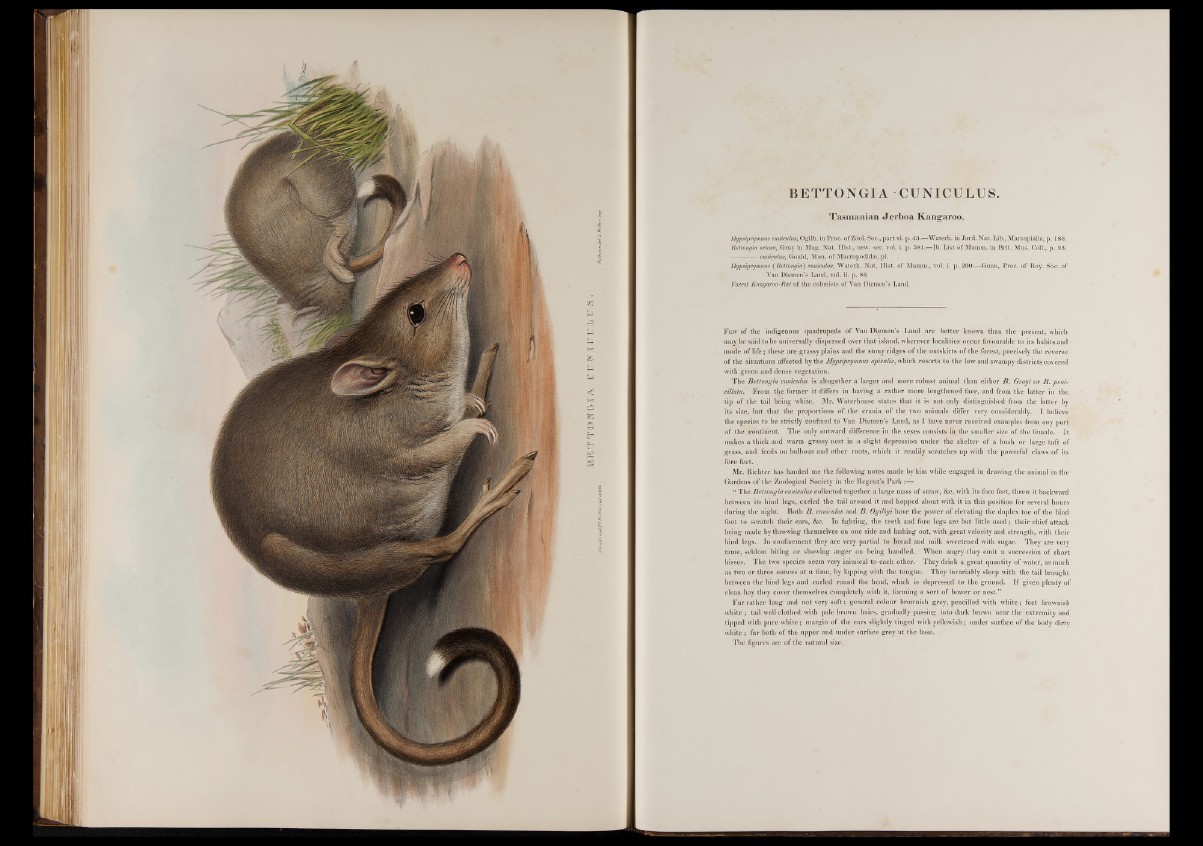
BET TO IT 0 1 A CITKTICITIL. U §
BETTONGIA CUNICULUS.
Tasmanian Jerboa Kangaroo.
Hypsiprynmus cmiculus, Ogilb. inProc. ofZool.,Soc.,partxi. p. 43.—Waterh. in Jard. Nat. Lib., Marsupialia, p. 186.
Bettongia setosa, Gray in Mag. Nat. Hist., new. ser. vol. i. p. 584^HEb. List of Mamm. in Brit. Mus. Coll., p. 93.
--------- — cmiculus, Gould, Mon. of Macropodidse, pi.
Hypsiprymuus (Bettongia) cmiculus, Waterh. Nat. Hist, of Mamm., vol. i. p. 200.—Gunn, Proc. of Roy. Soc. of
Van Diemen’s Land, vol. ii. p. 86.
Forest Kangaroo-Rat of the colonists of Van Diemen’s Land.
Few of the indigenous quadrupeds of Van Di.emen’s Land are better known than the present, which
may be said to be universally dispersed over that island, wherever localities occur favourable to its habits and
mdae of life; these are grassy plains and the stony ridges of the outskirts of the forest, precisely the reverse
of the situations affected by the Hypsiprymuus apicalis, which resorts to the low and swampy districts covered
with green and dense vegetation.
The Bettongia cuniculus is altogether a larger and more robust animal than either B. Grayi or B. peni-
cillata.’ From the former it differs in having a rather more lengthened face, and from the latter in the
tip of the tail being white. Mr. Waterhouse states that it is not only distinguished from the latter by
its size, but that the proportions of the crania of the two animals differ very considerably. I believe
the species to be strictly confined to Van Diemen’s Land, as I have never received examples from any part
of the continent. The only outward difference in the sexes consists in the smaller size of the female. It
makes a thick and warm grassy nest in a slight depression under the shelter of a bush or large tuft of
grass, and feeds on bulbous and other roots, which it readily scratches up with the powerful claws of its
fore feet.
Mr. Richter has handed me the following notes made by him while engaged in drawing the animal in the
Gardens of the Zoological Society in the Regent’s Park :•—
“ The Bettongia cuniculus collected together a large mass of straw, &c. with its fore feet, threw it backward
between its hind legs, curled the tail around it and hopped about with it in this position for several hours
during the night. Both B . cuniculus and B . Ogilbyi have the power of elevating the duplex toe of the hind
foot to scratch their ears, &c. In fighting, the teeth and fore legs are but little used; their chief attack'
being made by throwing themselves on one side and lashing out, with great velocity and strength, with their
hind legs. In confinement they are very partial to bread and milk sweetened with sugar. Thev are very
tame, seldom biting or showing anger on being handled. When angry they emit a succession of short
hisses. The two species seem very inimical to each other. They drink a great quantity of water, as much
as two or three ounces at a time, by lapping with the tongue. They invariably sleep with the tail brought
between the hind legs and curled round the head, which is depressed to the ground. If given plenty of
clean hay they cover themselves completely with it, forming a sort of bower or nest.”
Fur rather long and not very soft; general colour brownish grey, pencilled with white; feet brownish
white ; tail well clothed with pale brown hairs, gradually passing into dark brown near the extremity and
tipped with pure white; margin of the ears slightly tinged with yellowish; under surface of the body dirty
white ; fur both of the upper and under surface grey at the base.
The figures are of the natural size.